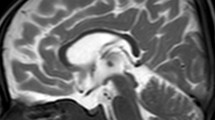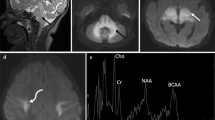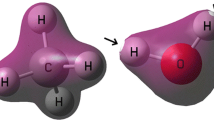Abstract
Objectives
The aim of this study is to examine metabolite changes in different brain regions of the children with vitamin B12 deficiency disease using MR spectroscopy.
Methods
Eighteen children with serum vit. B12 deficiency and 12 healthy volunteer children were included in the study. All children were examined with single-voxel spectroscopy examination via 1.5-Tesla MRI. The spectra were obtained from the left frontal periventricular white matter, left lentiform nucleus and left cerebellar hemisphere. The comparisons between patient group and control group were made with ratios calculated as NAA/Cr, Cho/Cr, mI/Cr, and Glx/Cr. All brain images were also examined in terms of brain atrophy, abnormal brain parenchyma intensity changes, or myelination status.
Results
The children were between 3 months and 16 years old in the patient group, and between 3 months and 15 years old in the control group. There were no statistical differences in terms of metabolite ratios in the three different brain regions between the patients and control group. In two patients, periventricular white matter hyperintensities were observed. In four patients, brain atrophy was detected.
Discussion
MR spectroscopy examination demonstrated that there were no statistical differences in terms of all metabolite ratios in left frontal periventricular white matter, left lentiform nucleus and left cerebellar hemisphere.



Similar content being viewed by others
References
Brocadello F, Levedianos G, Piccione F, Manara R, Pesenti FF (2007) Irreversible subacute sclerotic combined degeneration of the spinal cord in a vegan subject. Nutrition 23:622–624
Honzik T, Adamovicova M, Smolka V, Magner M, Hruba E, Zeman J (2010) Clinical presentation and metabolic consequences in 40 breastfed infants with nutritional vitamin B12 deficiency-what have we learned? Eur J Paediatr Neurol 14:488–495
Reynolds E (2006) Vitamin B12, folic acid, and the nervous system. Lancet Neurol 5(11):949–960
Lövblad K, Ramelli G, Remonda L, Nirkko AC, Ozdoba C, Schroth G (1997) Retardation of myelination due to dietary vitamin B12 deficiency: cranial MRI findings. Pediatr Radiol 27(2):155–158
De van der Schueren MA, Lonterman-Monasch S, van der Flier WM, Kramer MH, Maier AB, Muller M (2016) Malnutrition and risk of structural brain changes seen on magnetic resonance imaging in older adults. J Am Geriatr Soc 64(12):2457–2463
Kitamura T, Gotoh S, Takaki H, Kiyuna F, Yoshimura S, Fujii K (2016) A case of vitamin B12 deficiency with involuntary movements and bilateral basal ganglia lesions. Rinsho Shinkeigaku 56(7):499–503
Chakrabarty B, Dubey R, Gulati S, Yoganathan S, Kumar A, Kumar A (2014) Isolated cerebellar involvement in vitamin B12 deficiency: a case report. J Child Neurol 29(11):NP161–NP163
Taskesen M, Yaramis A, Pirinccioglu AG, Ekici F (2012) Cranial magnetic resonance imaging findings of nutritional vitamin B12 deficiency in 15 hypotonic infants. Eur J Paediatr Neurol 16(3):266–270
Ekici F, Tekbas G, Hattapoğlu S, Yaramış A, Önder H, Bilici A (2016) Brain MRI and MR spectroscopy findings in children with nutritional vitamin B12 deficiency. Clin Neuroradiol 26(2):215–220
Barkovich AJ (2005) Normal development of the neonatal and infant brain, skull and spine. In: Barkovich AJ (ed) Pediatric neuroimaging, 4th edn. Lippincott Williams and Wilkins, Philadelphia, pp 17–75
Kreis R (2004) Issues of spectral quality in clinical H1-magnetic resonance spectroscopy and a gallery of artifacts. NMR Biomed 17:361–381
Ghosh N, Holshouser B, Oyoyo U, Barnes S, Tong K, Ashwal S (2017) Combined diffusion tensor and magnetic resonance spectroscopic imaging methodology for automated regional brain analysis: application in a normal pediatric population. Dev Neurosci 39(5):413–429
Ford TC, Downey LA, Simpson T, McPhee G, Oliver C, Stough C (2018) The effect of a high-dose vitamin B multivitamin supplement on the relationship between brain metabolism and blood biomarkers of oxidative stress: a randomized control trial. Nutrients 10(12):1860
Arora K, Sequeira JM, Alarcon JM, Wasek B, Arning E, Bottiglieri T, Quadros EV (2018) Neuropathology of vitamin B(12) deficiency in the Cd320(−/−) mouse. FASEB J 33:2563–2573. https://doi.org/10.1096/fj.201800754RR
Taylor MJ, Selvaraj S, Norbury R, Jezzard P, Cowen PJ (2009) Normal glutamate but elevated myo-inositol in anterior cingulate cortex in recovered depressed patients. J Affect Disord 119(1–3):186–189
Kierans AS, Kirov II, Gonen O, Haemer G, Nisenbaum E, Babb JS, Grossman RI, Lui YW (2014) Myoinositol and glutamate complex neurometabolite abnormality after mild traumatic brain injury. Neurology. 82(6):521–528
Curtis DR, Watkins JC (1960) The excitation and depression of spinal neurones by structurally related amino acids. J Neurochem 6:117–141
Meldrum BS (2000) Glutamate as a neurotransmitter in the brain: review of physiology and pathology. J Nutr 130(4S Suppl):1007–1015
Blasco H, Mavel S, Corcia P, Gordon PH (2014) The glutamate hypothesis in ALS: pathophysiology and drug development. Curr Med Chem 21(31):3551–3575
Lin Y, Desbois A, Jiang S, Hou ST (2004) Group B vitamins protect murine cerebellar granule cells from glutamate/NMDA toxicity. Neuroreport. 15(14):2241–2244
Hung KL, Wang CC, Huang CY, Wang SJ (2009) Cyanocobalamin, vitamin B12, depresses glutamate release through inhibition of voltage-dependent Ca2+ influx in rat cerebrocortical nerve terminals (synaptosomes). Eur J Pharmacol 602(2–3):230–237
Gupta L, Gupta RK, Gupta PK, Malhotra HS, Saha I, Garg RK (2016) Assessment of brain cognitive functions in patients with vitamin B12 deficiency using resting state functional MRI: a longitudinal study. Magn Reson Imaging 34(2):191–196
Roy B, Trivedi R, Garg RK, Gupta PK, Tyagi R, Gupta RK (2015) Assessment of functional and structural damage in brain parenchyma in patients with vitamin B12 deficiency: a longitudinal perfusion and diffusion tensor imaging study. Magn Reson Imaging 33(5):537–543
Author information
Authors and Affiliations
Corresponding author
Additional information
Publisher’s note
Springer Nature remains neutral with regard to jurisdictional claims in published maps and institutional affiliations.
This study has been presented as an e-poster at the annual meeting of European Society of Neuroradiology (ESNR), Malmö, Sweden, September 2017.
Rights and permissions
About this article
Cite this article
Dokumaci, D.S., Dogan, F., Geter, S. et al. Does B12 deficiency lead to change in brain metabolites in pediatric population? A MR spectroscopy study. Neurol Sci 40, 2319–2324 (2019). https://doi.org/10.1007/s10072-019-03990-5
Received:
Accepted:
Published:
Issue Date:
DOI: https://doi.org/10.1007/s10072-019-03990-5




